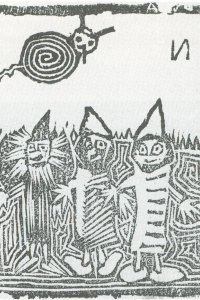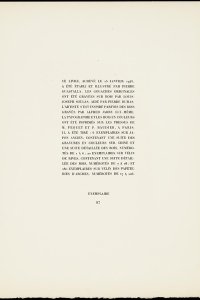L'autoclète : guignol
- Year:
- 1948
- Author:
- Alfred Jarry (1873 - 1907)
- Artist:
- Pierre Guastalla (1891 - 1968)
- Publisher:
- Chez l'artiste
Printing history
The history of L'autoclète: guignol is complicated. The text is part of a cycle of plays, Les Polyèdres, written by Jarry before his world-shattering absurdist play Ubu roi was first performed in 1896. The very same Ubu, a character based on a pompous physics teacher, is the main character in Les Polyèdres- later dubbed Ubu cocu. It was first published, along with other texts, under the name 'Guignol' (puppet theatre) in the magazine L'echo de Paris littéraire illustré in 1893. A year later, L'autoclète became a part of Jarry's first book: Les minutes de sable memorial. A reprint of this text was produced in 1932 by Jean Saltas, a friend of Jarry's. The full play Ubu cocu didn't appear until 1944.
The edition of L'autoclète that was produced independently by Pierre Guastalla in an edition of 206 copies appeared in 1948. The text was printed by the renowned printingstudio of Marthe Fequet and Pierre Baudier. This family printing business collaborated on the publication of hundreds of deluxe book edition, including editions of Braque and Matisse.
Bibliographical description
- Description:
- L'autoclète : guignol / Alfred Jarry ; gouaches de Pierre Guastalla, grav. par L.-J. Soulas. - [Paris] : Chez l’artiste, 1948. - [28] p. : ill. ; 33 cm
- Printer:
- M. Fequet and P. Baudier (Paris)
- Edition:
- 206 copies
- This copy:
- Number 97 of 180 on Arches
- Bibliography:
- Bénézit 6-518 ; Bénézit 13-63 ; Monod 6376
- Shelfmark:
- Koopm A 569
References
- Alfred Besnier, Alfred Jarry. Paris, Plon, 1990
- Paul van Capelleveen, Sophie Ham, Jordy Joubij, Voices and visions. The Koopman Collection and the Art of the French Book. The Hague, Koninklijke Bibliotheek, National Library of the Netherlands; Zwolle, Waanders, 2009
- Paul van Capelleveen, Sophie Ham, Jordy Joubij, Voix et visions. La Collection Koopman et l'Art du Livre français. La Haye, Koninklijke Bibliotheek, Bibliothèque nationale des Pays-Bas; Zwolle, Waanders, 2009
- Judith Cooper, Ubu roi: An analytical study. New Orleans, Tulane University, 1974
- Fiorini, 'Pierre Guastalla: Peintre et graveur', in: Revue d'esthetique 22-1 (1969)
- Franse grafiek van nu. Amsterdam, Stedelijk Museum Amsterdam, [1946]
- W.J. Strachan, The artist and the book in France: The twentieth century livre d’artiste. London, Owen, 1969

![Page [5]](/sites/default/files/styles/galerie/public/images/lautoclete-p5.jpg?h=825eb4f8&itok=XcZrKAuU)
![Page [13]](/sites/default/files/styles/galerie/public/images/lautoclete-p13.jpg?h=94488d80&itok=h8ay7uyp)
![Page [23]](/sites/default/files/styles/galerie/public/images/lautoclete-p23.jpg?h=6a8ae56f&itok=OZvXZWSg)

